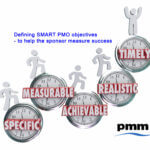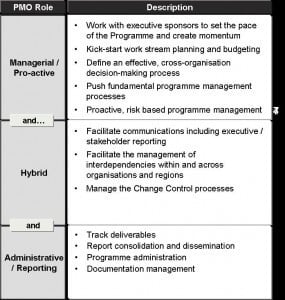In the last post, Defining objectives for a PMO to help the sponsor measure success, it provided and overview of how to define objectives to help the sponsor understand the value provided by a PMO. The post included a simple action plan covering the important points.
This post will expand on the first 2 points in the Action Plan.
1. Agree Objectives
Before embarking on any project, including designing and implementing PMO, you must know what is the objective. This means that you must ensure that the following is understood and agreed by senior management / PMO sponsor:
- Business drivers
- Problems to be solved
- Expected / required benefits
- Known constraints to work within (budget)
- Time frames
There is no right or wrong way to define the objectives. However, there are some principles that should be followed:
- Ensure senior management / PMO sponsor engagement
- Ensure views are canvassed from stakeholders
- Avoid making assumptions based on the PMO you would like to implement
- Avoid talking in “solutions” so as not to lead conversations
- Consolidate and document inputs
- Review and refine with senior management, stakeholders and PMO sponsor
Capturing and agreeing objectives is like capturing project requirements. You need to ensure you ask the right questions of the right people. Then review and consolidate the inputs and document. This can then be presented back to senior management and PMO sponsor to allow refinement and sign-off.
You should be aiming for very clear objectives that are realistic and easily understood. Then you will have a chance of designing and implementing a PMO to meet these objectives, resulting in happy senior management and PMO sponsor.
Example objectives met by PMO
- Visibility of all projects of budget > £5 million
- Standard reporting to be used by all projects
- Reduce mobilisation time of project to xx weeks
- Prioritise and approve projects based on standard metrics
- Improve quality of project delivery
- Improve certainty of project delivery
- Improve the return on investment of projects
There are many others and, in my experience, getting to the position of visibility of all projects over a certain size using a standard reporting mechanism, is a big win for many organisations without mature change management.
2. Translate to SMART objectives
The good news is, by completing step 1 you should have a clear understanding on what objectives the PMO must be able to meet to be successful. However, so that you can demonstrate that the objectives have been met, you do need to ensure that progress can be measured. This is where you should try to use SMART objectives.
While going through step 1 to capture and agree objectives is a good start, in most cases you will have what are termed “not so SMART objective”. This does not mean that the objective is not good, it means that it is not SMART – it can not be measured. If you can not measure, how will you know if you have been successful in your endeavours? More importantly how will you demonstrate to your sponsor (boss) that you have been successful?
Many organisations strive to use SMART objectives as they provide structure and, most importantly, can be measured. This suits most goal orientated people as they have a very clear understanding of what needs to be achieved, by when and what will be the resulting outcome (benefit).
Below is an example SMART objectives worksheet that can be used to take each “Non SMART” objective and translate it to a SMART objective.
When you have a good set of SMART objectives, review with senior management, stakeholders and PMO sponsor. Refine as appropriate and then secure sign-off. You are now ready for Step 3 – define vision, mission and design principles. These will be covered in the next post.







